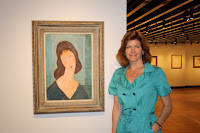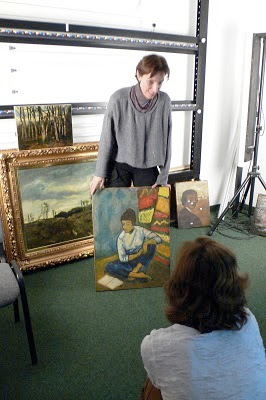Tuesday, April 01, 2014 -  Colette Marvin,fakes and forgeries
Colette Marvin,fakes and forgeries
 No comments
No comments
 Colette Marvin,fakes and forgeries
Colette Marvin,fakes and forgeries
 No comments
No comments
Colette Loll's "Intent to Deceive: Fake and Forgeries in the Art World" on display at Springfield Museums until April 27
 |
| Han van Meegeren, Portrait of a Lady, Yale University Art Gallery |
Colette Loll, who attended ARCA's 2009 Postgraduate Certificate Program in Art Crime and Cultural Heritage Protection in Amelia, is the curator of "Intent to Deceive: Fakes and Forgeries in the Art World", an independent exhibit currently on display at the Michele & Donald D'Amour Museum of Fine Arts in Springfield, MA.
The exhibit looks at the forgery careers of Han van Meegeren (1889-1947), Elmyr de Hory, Eric Hebborn, John Myatt, and Mark Landis.
The "Gallery" section of the website for "Intent to Deceive" includes four works by van Meegeren: Girl with the Blue Bow, in the style of Johannes Vermeer (Dutch, 1632-1675), ca. 1924, gelatin-glue medium and pigment over obscured 17th century painting fragment, courtesy of The Hyde Collection, Glens Falls, New York; Portrait of a Lady, 20th century, oil on canvas, courtesy of Yale University Art Gallery, Mabel Brady Garvan Fund; Head of Christ, in the style of Vermeer, 1940-41, oil on canvas, courtesy of Museum Boijmans Van Beuningen, Rotterdam; and The Procuress (after Baburen), in the style of Dirck van Baburen (Dutch, c. 1595 -1624), 1940, oil on canvas, courtesy of The Samuel Courtauld Trust, The Courtauld Gallery, London.
In an interview with Patricia Cohen's Dec. 31, 2013 article "So Valuable, It Could Almost Be Real" in The New York Times, Ms. Loll explained:
The "Gallery" section of the website for "Intent to Deceive" includes four works by van Meegeren: Girl with the Blue Bow, in the style of Johannes Vermeer (Dutch, 1632-1675), ca. 1924, gelatin-glue medium and pigment over obscured 17th century painting fragment, courtesy of The Hyde Collection, Glens Falls, New York; Portrait of a Lady, 20th century, oil on canvas, courtesy of Yale University Art Gallery, Mabel Brady Garvan Fund; Head of Christ, in the style of Vermeer, 1940-41, oil on canvas, courtesy of Museum Boijmans Van Beuningen, Rotterdam; and The Procuress (after Baburen), in the style of Dirck van Baburen (Dutch, c. 1595 -1624), 1940, oil on canvas, courtesy of The Samuel Courtauld Trust, The Courtauld Gallery, London.
In an interview with Patricia Cohen's Dec. 31, 2013 article "So Valuable, It Could Almost Be Real" in The New York Times, Ms. Loll explained:
What links these men, said Colette Loll, the exhibition’s curator and an art investigator, are “frustrated artistic ambitions, chaotic personal lives and a contempt for the art market and its experts.” Ms. Loll, who organized the exhibition with the nonprofit group International Arts & Artists, said she was shocked when she heard the $31,000 estimate for the security arrangements demanded by just the Boijmans. That sum is close to the $39,500 that “Christ and the Scribes in the Temple” — the painting van Meegeren created in 1945 to prove he was a forger rather than a collaborator — fetched at Christie’s auction house in 1996.
Jonathan Keats, author of Forged: Why Fakes Are The Great Art of Our Time (Oxford University Press, 2013) -- reviewed in The Journal of Art Crime in the Spring 2013 issue -- wrote about the exhibit on March 27th for Forbes in "At This Massachusetts Art Museum, Some Forgeries Are Faker Than Others (But Better Not Trust Your Eyes)":
An important exhibition of art forgeries curated by Colette Loll, currently at the D’Amour Museum of Fine Arts, naturally provokes this question. Intent to Deceive includes the forgeries of some of these great fakers together with works painted as their own. Comparisons are revealing.
As a matter of visual impact, both categories are approximately equivalent. De Hory’s Picassos and Myatt’s Monets remain aesthetically consistent before and after these men confessed. Creative permutations on the artists’ signature style, the paintings serve the beneficial role – as I argued in my book Forged – of posthumously increasing Picasso and Monet’s output. (Perhaps Picasso didn’t need it.)
On the other hand, there is a profound conceptual difference between paintings made before and after the forgers confessed. The fraudulent fakes of these forgers were remarkably subversive, exploiting the unjustified assumptions of the society in which they were operating (such as the infallibility of institutional authority). When the forgeries were discovered to be fake, those unjustified assumptions were called into question. The most important function of art in our time – as a psychological and social provocation – was spectacularly served by these counterfeits. Lacking the context of fraudulence, the later works of Myatt, Hebborn and de Hory are conceptually flat.
Here's a link to a post about the Kickstarter campaign on the documentary "Art and Craft" featuring the work of Mark Landis.But never trust a master faker. Though John Myatt appears to have gone completely straight, Eric Hebborn managed to confound the art world even more totally after he started selling Hebborns in the ’80s, because they advertised his consummate skill as rumors arose that he was still faking. And de Hory? Don’t believe the bit about his aristocratic heritage. His true life story is still getting sorted out, and there are rumors that a factory in China has been faking signed Elmyrs.







